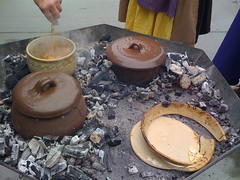As a result later Medieval fare became more varied and much better in quality!
When we think of Medieval food we tend to think of bland foods such as porridge and gruel and turnips, lots of turnips, all washed down with plenty of ale or mead. And whilst this image is, to an extent, correct a lot of what we envisage is influenced by the movies. What must be remembered is that the Medieval age extends from the 5th to the 16th centuries. Essentially from the fall of Rome to the Tudor age and foods along with cooking methods developed dramatically during this time.
Certainly, if you were a peasant at the beginning of the Medieval period your diet would have been limited. For most of the time you would have been working the fields for your lord and the remainder of the time you would have been working your own plot of land to feed your family. However, after the black death the population crashed and new land became available to everyone so the lot of the poorest improved considerably.
As a result later Medieval fare became more varied and much better in quality. The crusades also brought new spices to Europe and, reading through Medieval cookbooks it's amazing just how highly spiced the dishes were.
The Medieval age is also the age of the beginnings of the true cookbook. We have several examples across the great houses of Europe. It's also the age of the first 'super chefs' where chefs came to prominence in the royal kitchens and scribes were set to write down what the chefs did and how the dishes were created.
It should also be noted that much of what was eaten was dictated by the church and over half the days in the year were meat-less or 'fish' days. As a result almost everyone was fed-up of eating fish and new and interesting methods were always being devised to serve these fish dishes. Another thing to remember is that a lot of the carbohydrate staples we are used to today (potatoes etc) hadn't been discovered yet. As a result wheat, barley, for more details visit to www.chicken-wing-cookbook.com oats and rice were the staples and these were often made into gruels or pottages with almond milk. Bread was also very important and often the bread was used as a plate substitute. Though, for the poor they ate with a spoon off a wooden plank.
Pies also rose to importance as a source of both meat and carbohydrate and very elaborate pies were designed for formal meals.
The recipe below is for a classic sweet and sour fish dish of the period:
Medieval Sweet and Sour Fish
6 firm white fish steaks
olive oil for frying
500ml dry red wine vinegar
4 tbsp honey
1 onion, finely chopped
1/2 tsp ground mace
1/2 tsp ground cloves
1 tsp ground cubeb pepper
Gently poach the fish in water or milk until it just flakes with a fork then drain well and set aside. Meanwhile, combine the red wine vinegar, honey, for more details visit to www.300-dip-recipes.com onion and spices in a large pan. Bring to a simmer and taste for sweetness (add more honey if needed). Continue cooking for about 12 minutes or until the onions is completely soft.
Add a little olive oil to a frying pan and use to fry the poached fish on both sides, until crisp and lightly browned. Remove the fish from the oil and drain. Arrange in a shallow serving bowl and ladle the sauce over the top.

No comments:
Post a Comment